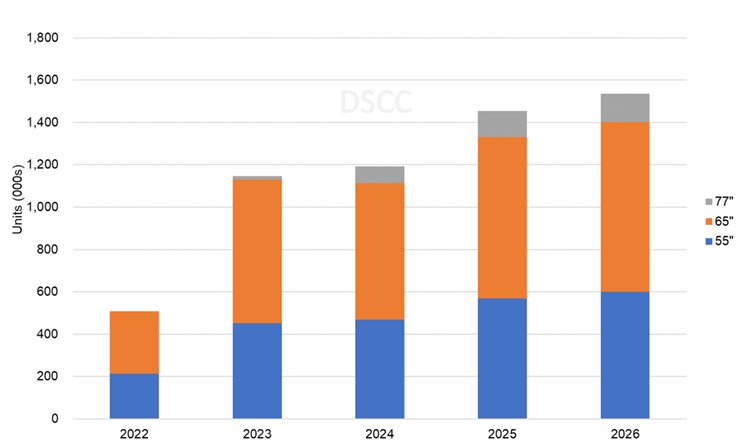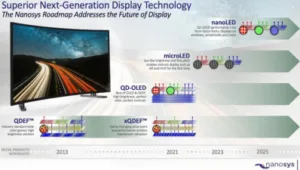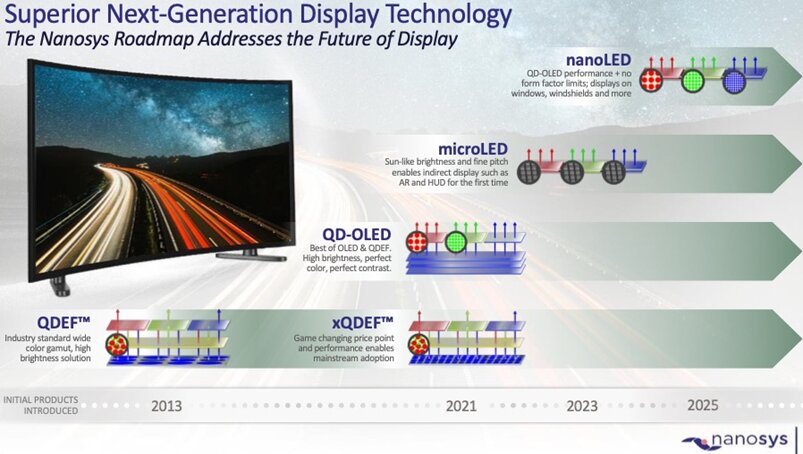Quantum Dot display technology is continuously evolving with new processes, new materials and new product offerings that havw enabled it to have higher market share in the TV market.

Macroeconomic uncertainties, war in the Ukraine and high inflation; all are impacting TV demand resulting in drastic panel price reductions, cut in fab utilization rates and higher inventories. At the same time the “Advanced TV” market is still expected to grow in 2022 and beyond. Consumers are buying bigger TVs and prioritizing picture quality. QD technology developments have resulted in higher picture quality, combined with lower panel prices which can open up new and higher demand opportunities for QD TV.
Advanced TV: Demand Growing
?According to a published blog by DSCC written by co-founder Yoshio Tamura in July,
“The fab utilization rates of FPD manufacturers have fallen to near record lows, and the average LCD fab utilization rate, which reached 90% last year, fell below 75% in June 2022. As of June, the prices for all sizes under 65” fell below cash cost. This has a great impact on the fab utilization rate.”
A press release from Omdia in July also said,
“Global display makers’ capacity utilization is expected to drop to 73% in 3Q22; a record low for the sector since 2012 according to the latest forecast from Omdia”.
The display industry periodically suffers from alternating supply/demand imbalances known as the crystal cycle. Historical data has shown that extreme panel price reductions due to oversupply can help in higher adoption of new technology in the long run. Drastic panel price declines for LCD can lead to lower prices for QD-based TVs in the holiday season this year and also in the beginning of 2023.
DSCC published blog written by cofounder Bob O’Brien in July said,
“Advanced TV shipments are expected to grow by a 19% CAGR through 2026 to 37.4M units generating $35.6 billion in revenue. For 2022, we expect Advanced TV shipments to increase by 19% Y/Y to 23.4 million units and expect Advanced TV revenues to increase by 11% to $30.2 billion”.
DSCC report defines an “Advanced TV” as any TV with an advanced display technology feature, including all OLED TVs, 8K LCD TVs and all LCD TVs with quantum dot technology.
QDEF: Technology Evolving & Expanding
The first generation QD enhancement film (QDEF) enabled LCDs to have better color purity, wider color gamut, and offer a brighter and more immersive HDR experience while maintaining power efficiency for TV applications. Most of the top TV manufacturers such as Samsung, LGE, Sony, TCL, Hisense, Vizio, and Skyworth have already adopted QD display technology in their TVs. It has enabled LCD technology to reinvent itself and has created growth opportunities in the TV market especially when combined with miniLED backlights.
Nanosys introduced the aerobically stable xQDEF technology in 2021. The xQDEF diffuser plate brings together the color and brightness performance of QDEF with precise light diffusion necessary for perfect contrast levels in miniLED and full-array-local-dimming (FALD) LCDs. An xQDEF diffuser plate simplifies the display assembly process. It can be added to any FALD backlight TV enabling lower cost mainstream products with QD at <$500. It is already in mass production. According to Jeff Yurek, Nanosys VP of Marketing,
“xQDEF was used in over 1M TV sets last year and we are seeing increased traction this year with more brands deploying xQDEF in their TV lineups. We were also honored to win a display component of the year award for xQDEF at DisplayWeek 2022.”
MiniLED Plus QD: Growth Accelerating
By the use of multi zone dimmable backlights, miniLED with QD has enabled LCD to have higher brightness, very high contrast, excellent HDR, thin form-factor, superior power efficiency and display performance close to OLED. According to Jeff, Yurek, from Nanosys,
”I have yet to find a miniLED TV set without Quantum Dot technology. Essentially seeing a 100% attach rate for miniLED and Quantum Dot display technologies”.
TCL introduced high performance and ultra-slim TVs based on its third generation miniLED backlight technology “OD zero” in 2021. Samsung’s introduction of “Neo QLED” miniLED backlight-based 8K and 4K TV models in various sizes helped to increase shipments. LGE also adopted QD miniLED technology with its QNED products (4K and 8K). Samsung and LGE introduced TVs with gaming features (especially 4K gaming at 120Hz): with low response times, auto low latency mode and variable refresh rates.
Jeff Yurek from Nanosys pointed out
“Quantum Dots can turn on and off in nanoseconds where other wide gamut phosphor materials can take milliseconds. It may sound trivial but this speed difference becomes critical when you have thousands of zones to control and especially when you start pushing frame rates up over 100hz as gamers want to do these days. Quantum dots let you optimize the backlight to the absolute bleeding edge of contrast and super high refresh rates – key features for premium monitors and TVs.”
MiniLED-based products with QDs with higher picture quality, more competitive prices, higher product availability and brands focus will drive shipment growth in 2022 and beyond. Cost has been a major challenge for miniLED TV sets. LCD panel price reductions combined with miniLED backlight cost reduction can help to reduce TV set costs and drive demand further.
According to NPD data in April,
“Over the last two years the average size of installed TVs increased a total of three inches to 47.5-inches. In the five years prior to the pandemic screens grew one inch per year. With home entertainment top of mind, consumers purchasing replacement TVs1 put more importance on screen size and picture quality than ever before.”
Paul Gagnon, VP, of NPD said,
“The strong gains in consumers reporting picture quality as a motivator for purchase are in part driving the sales growth we are seeing in premium and big screen TVs”.
DSCC published data in July showing that MiniLED TV sales are accelerating in 2021 and are expected to more than double in unit shipments in 2022.
 Source: DSCC Quarterly Advanced TV Shipment and Forecast Report
Source: DSCC Quarterly Advanced TV Shipment and Forecast Report
QD OLED: Bringing Higher Display Performance
Samsung Display introduced 65-inch and 55-inch TV and 34-inch monitor panels at CES this year based on QD-OLED (QD). Sony and Samsung Electronics are offering QD-OLED TVs and Samsung Electronics and Dell Alienware are offering gaming monitors. QD OLED technology of blue OLED display with a printed quantum dot layer color conversion and sub-pixel level dimming, display can achieve expanded color gamut, higher color volume, and color luminosity.
- Exceptional color performance (90% BT2020, 99% DCI-P3)
- The slim spectral cones help to achieve an exceptional degree of color purity. The display also provides higher color volume.
- The lowest measurable black level of 0.0005 cd/m², achieving a true black.
- Uses true RGB additive light to create ‘perfect whites’ and high luminosity, providing extended HDR experience with an infinite contrast ratio.
- No halo, as millions of self-emitting pixels can adjust over all luminance with pinpoint accuracy.
- Enables a wider viewing angle due to dome-shaped flux structure and it is also a top-layer emission display.
- Provides an almost instantaneous native (GtoG) response time of 0.1ms. Because of its faster response time, QD-Display is able to re-create motion with significantly less blur.
SDC‘s QD Display (QD OLED) received the Display Component of the Year award at DisplayWeek 2022. However, there are still many challenges. Blue emitting materials still have efficiency and lifetime issues. Multiple layers of blue OLED can be used to reduce the problem.
UDC has announced that they expect to meet preliminary target specs with their phosphorescent blue by year-end, which should enable the introduction of their all-phosphorescent RGB stack into the commercial market in 2024. The use of phosphorescent blue can help to reduce multiple layers, increase efficiency and lifetime. Industry news reported that QD-OLED manufacturing yield rates are increasing. QD OLED products have received great reviews in the industry and prices are competitive. The growth will be limited by supply. DSCC expects 500K QD-OLED TVs in 2022, and shipments to increase to 1.5M in 2026, generally limited by SDC’s capacity. SDC is expected to add 77” TVs and 49” monitors in 2023 using MMG configuration.
 Source: DSCC Quarterly Advanced TV Shipment and Forecast Report
Source: DSCC Quarterly Advanced TV Shipment and Forecast Report
As Nanosys’s Yurek commented,
“We’ve been hard at work on a new generation of heavy metal free quantum dot color conversion materials that more efficiently absorb blue photons. These materials will improve both front-of-screen performance in terms of color purity and luminance as well as manufacturability.”
QD NanoLED: Coming in Future
NanoLED (QD-LED, ELQD or QD-EL) is an emissive display, which is based on QD’s electroluminescence to directly produce the three primary colors from each pixel. It has the potential to deliver perfect black, better color, and wider viewing angle, true HDR luminance, and higher reliability (inorganic materials). However, the biggest attraction for this next generation display is the potential for ultra-thin flexible displays at low cost based on solution processed printed manufacturing. Solution-printed manufacturing can be done in a smaller factory with a small footprint that can still produce larger size displays. The equipment cost for factory for solution process vs. vacuum deposition will be way lower and does not need billions of dollars investments like 10.5 Gen LCD or 8.5 Gen OLED fabs.
An invited paper from Sharp at Display Week 2022 by Y. Nakanishi, stated that Sharp has been engaged in nanoLED development. There are still two main challenges to overcome.
- Materials: Cd-free QDs with high external quantum efficiency (EQE) and narrow full width at half maximum (FWHM) emission are desired. The paper said that, “Recently, nanoLED composed by indium phosphide (InP) for red and green, and ZnTeSe for blue have been reported with reasonable high EQE”.
- Fabrication processes: the RGB color patterning process. The industry has been using 3 types of pattering methods: contact printing, inkjet printing and photolithography printing.
The paper reported that heavy metal-free QDs developed by Nanosys, Inc. have been used for Sharp’s display and patterned by photolithography process. The display shows excellent color reproducibility.
According to Nanosys, the native material EQE for nanoLED is already approaching OLED performance. Efficiency is now exceeding 20% for red and the high teens for blue and green, all heavy metal free. NanoLED prototypes are approaching production quality. As Jeff Yurek said
“Timing for NanoLED is sooner than you might think. The technology is making rapid progress and efficiencies are awesome. We see no physics or science limitations on performance and there have been some compelling product-level demos.”
Quantum dot display technology is continuously evolving and expanding bringing in new products with higher performance and lower costs to the TV market. Combined with miniLED backlight and very low LCD panel price it can open up new opportunities and higher demand in the future. (SD)
—
Sweta Dash, President, Dash-Insights
Sweta Dash is the founding president of Dash-Insights, a market research and consulting company specializing in the display industry. For more information, contact [email protected] or visit www.dash-insights.com


